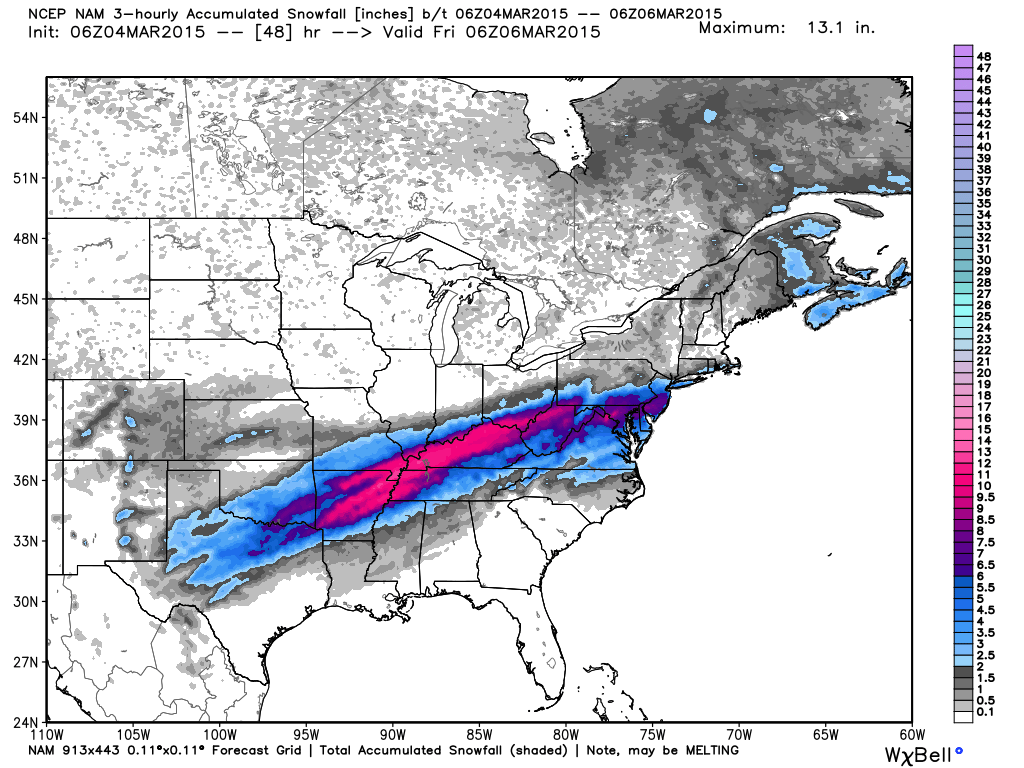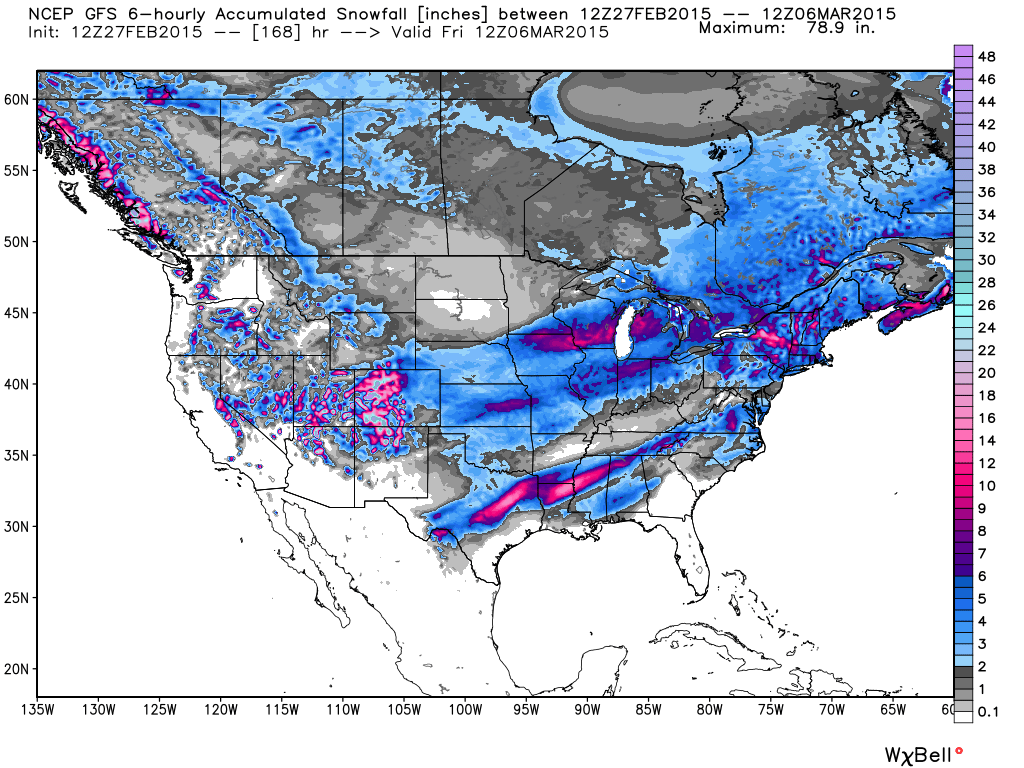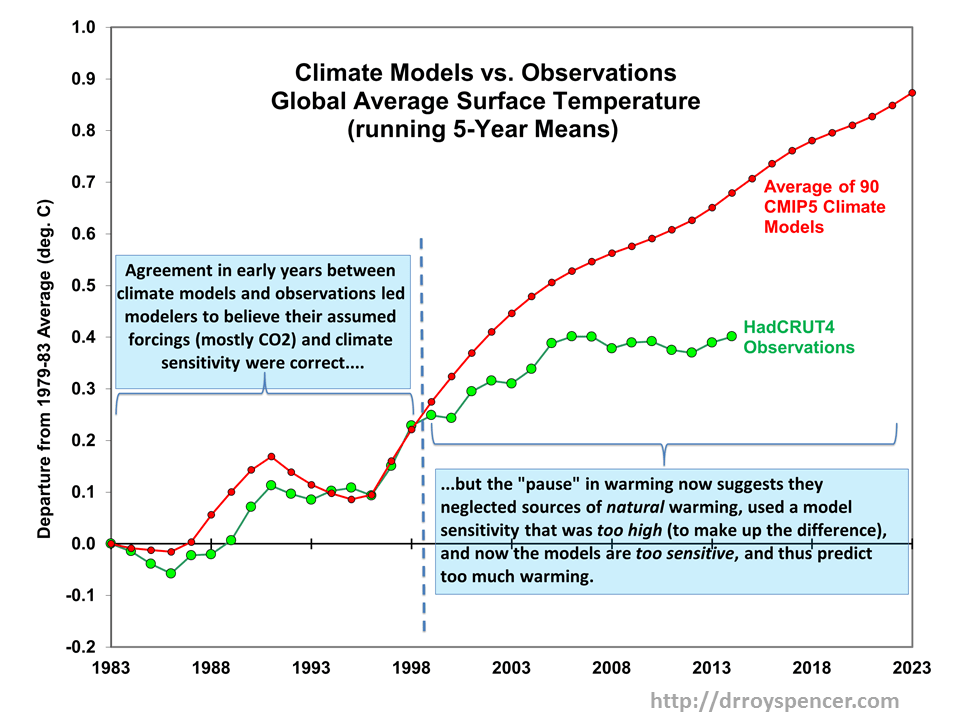Much of the Eastern U.S. finally had a clear day yesterday (March 6, 2015) , allowing the NASA MODIS imager to capture this extraordinary view of the new snow (up to 20 inches in Kentucky) laid down through the Ohio Valley and mid-Atlantic states (click for full-size):
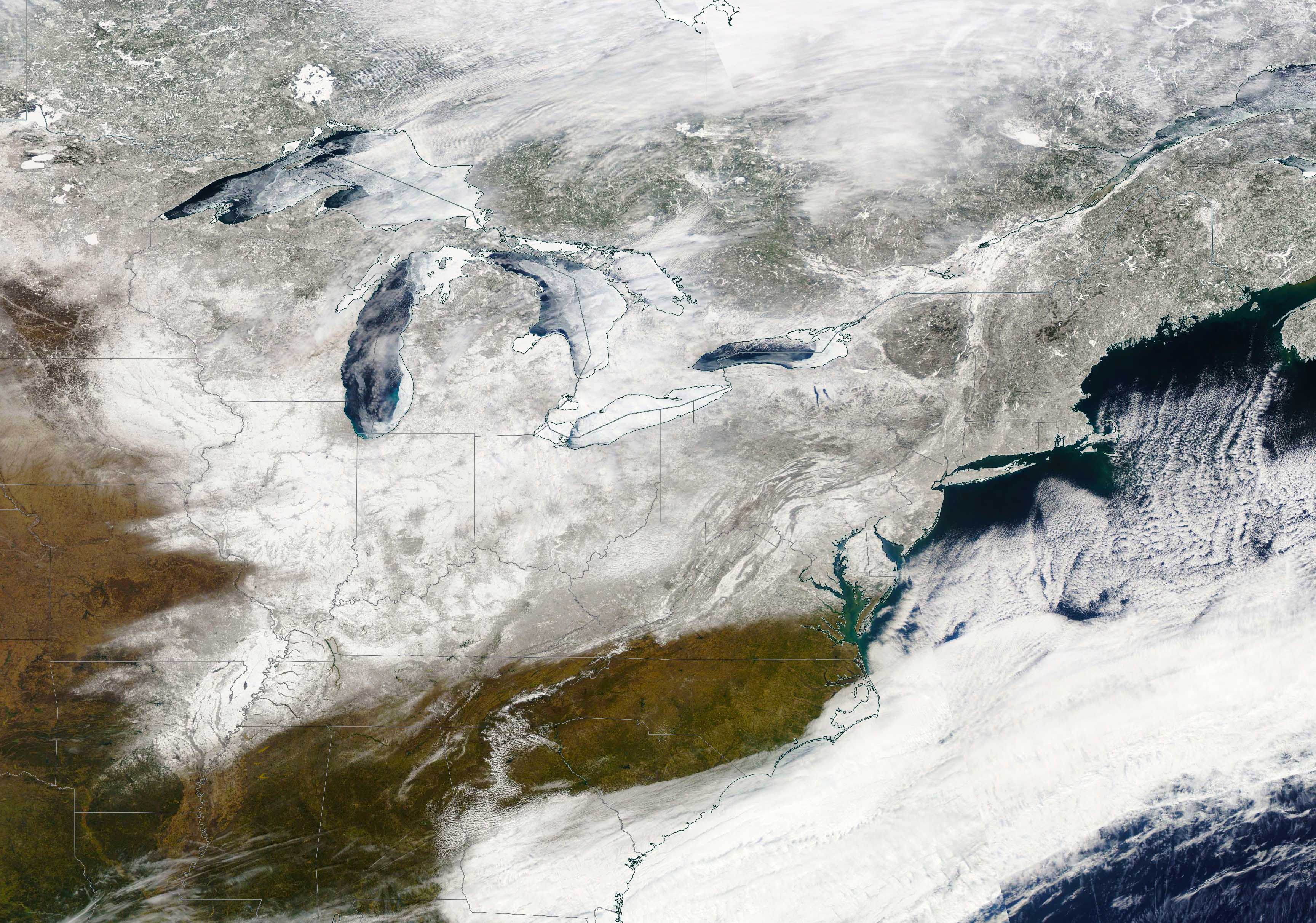
Archive for the ‘Blog Article’ Category
Extraordinary Color View of Eastern U.S. Snow Cover
Saturday, March 7th, 2015Of Bad Luck and Space Mission Numbering
Wednesday, March 4th, 2015 A couple of days ago, one of DoD’s polar-orbiting weather satellites — “F-13” — exploded. They aren’t sure why, but one insider has claimed it was an overheated battery. I guess I don’t see how an overheated battery causes the disintegration of a satellite into 40+ chunks, unless it ignited leftover hydrazine propellant.
A couple of days ago, one of DoD’s polar-orbiting weather satellites — “F-13” — exploded. They aren’t sure why, but one insider has claimed it was an overheated battery. I guess I don’t see how an overheated battery causes the disintegration of a satellite into 40+ chunks, unless it ignited leftover hydrazine propellant.
Now, I don’t consider myself superstitious, but there has been a pattern of failure among space missions involving the number “13”.
Out of the NOAA polar orbiting satellites (NOAA-6, -7, -8, -9, -10, -11, -12, -13, -14, -15, 16, -17, -18, -19), which one might you guess failed? That’s right, NOAA-13. In 1993 after less than 2 weeks on orbit, NOAA-13 experienced a short circuit in it’s battery charging system, rendering the satellite useless. In contrast, NOAA-15 is now in it’s 17th year of continuous operation.
And guess which Apollo mission nearly ended in disaster? Apollo-13, after an oxygen tank exploded and Tom Hanks almost single-highhandedly brought the Moon mission safely home.
And what about the GOES-13 geostationary weather satellite that failed just before hurricane season started (in 2013!). It was later brought back from the dead (after 2013, of course).
I think I would just skip “13” when numbering satellites. Maybe use “12A” instead.
And don’t get me started about calling a satellite “ADEOS”. The Japanese Earth observation satellites ADEOS-I and ADEOS-II both failed early in their missions from solar panel malfunctions. The successful follow-on Japanese satellite is GCOM-W, which fortunately doesn’t mean “bye-bye” in any language.
Oh! I almost forgot! The Japanese name for the 2 failed ADEOS satellites was “Midori”, which in Japanese means…wait for it…”green”.
UAH Global Temperature Update for Feb. 2015: +0.30 deg. C
Wednesday, March 4th, 2015The Version 5.6 global average lower tropospheric temperature (LT) anomaly for February, 2015 is +0.30 deg. C, down a little from the January 2015 value of +0.35 deg. C (click for full size version):
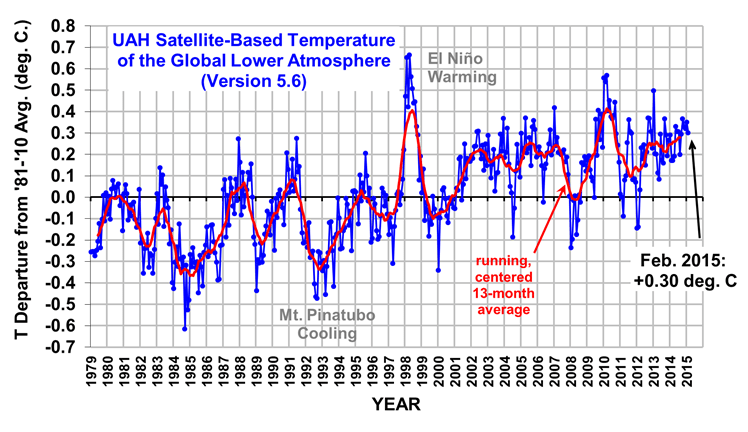
The global, hemispheric, and tropical LT anomalies from the 30-year (1981-2010) average for the last 14 months are:
YR MON GLOBAL NH SH TROPICS
2014 01 +0.291 +0.387 +0.194 -0.029
2014 02 +0.170 +0.320 +0.020 -0.103
2014 03 +0.170 +0.338 +0.002 -0.001
2014 04 +0.190 +0.358 +0.022 +0.092
2014 05 +0.326 +0.325 +0.328 +0.175
2014 06 +0.305 +0.315 +0.295 +0.510
2014 07 +0.304 +0.289 +0.319 +0.451
2014 08 +0.199 +0.244 +0.153 +0.061
2014 09 +0.294 +0.187 +0.401 +0.181
2014 10 +0.365 +0.333 +0.396 +0.189
2014 11 +0.329 +0.354 +0.303 +0.247
2014 12 +0.322 +0.465 +0.178 +0.296
2015 01 +0.351 +0.553 +0.150 +0.126
2015 02 +0.296 +0.434 +0.157 +0.015
Note that the El Nino warmth in the tropics seems to have fizzled, falling about 0.25 deg C in the last few months to near the 1979-2010 average value, which is unusual since February has been the usual time of peak tropospheric warmth in response to previous El Nino events.
The global image for February, 2015 should be available in the next day or so here.
Popular monthly data files (these might take a few days to update):
uahncdc_lt_5.6.txt (Lower Troposphere)
uahncdc_mt_5.6.txt (Mid-Troposphere)
uahncdc_ls_5.6.txt (Lower Stratosphere)
40 deg. Temperature Drop for Deep South
Wednesday, March 4th, 2015A strong cold front is forming today and will plunge through the Deep South, bringing a 40 deg. F temperature drop.
Here’s a time lapse video of hourly temperature forecasts from the WRF high resolution model, showing just how abrupt the temperature change will be as the front passes (original graphics from Weatherbell.com):
Winter storm warnings have been issued for northern portions of the South where up to a foot of snow is expected, mainly through the Ohio River Valley:
Snow for all 50 States Forecast in Next 7 Days
Friday, February 27th, 2015The unseasonable cold is expected to continue over much of the U.S., with some interruptions, and the latest GFS model forecast shows some snow for portions of all 50 states in the next seven days. (Graphic courtesy of Weatherbell.com, click for full-size):
And, yes, I checked…even in Hawaii.
On Natural Climate Variability and Climate Models
Friday, February 27th, 2015The “pause” in global warming is becoming increasingly difficult for the climate establishment to ignore, which is a good thing. They are now coming up with reasons why there has been a “pause” (a term I dislike because it implies knowledge of future warming, which no one has), and spinning it as if it is bad new for us.
But when they assume that natural climate variations can cause a cooling influence, they are also admitting there can be natural sources of warming.
A natural change in ocean circulation is the leading potential explanation for the pause. Due to the huge temperature difference between surface waters and deep water, any small change in ocean overturning can result in either warming or cooling of surface temperatures. If the ocean was isothermal with depth, such a mechanism would not exist.
The point of this post is to remind people of what I have stated before: to the extent that a change in ocean circulation has negated anthropogenic warming in the last 15+ years, an opposite change likely enhanced warming during the 1970s to 1990s.
You can’t have one without the other. Natural fluctuations in ocean vertical circulation are cyclical. You can’t attribute the recent warming hiatus to natural forcings without also addressing the role of potential natural forcings in causing the previous warming period. At best, it betrays a bias in reasoning; at worst, it is logically inconsistent.
This is not just a minor detail that is irrelevant to long-term climate predictions because the models were mostly developed (and modelers’ opinions regarding sensitivity formed) during a period (the 1970s to 1990s) when substantial natural warming was occurring, yet they assumed it was entirely manmade. Correcting for the mistake would alter our understanding of climate change as well as any proposed energy policies to (supposedly) avert it.
This is why the paper we published in APJAS last year was so important. It demonstrated that El Ninos change the planetary radiation budget, allowing more solar heating of the system. The paper was rejected out of hand by many in the climate establishment simply because it did not support the IPCC party line. (Odd, since our results potentially explain why their models continue to produce, on average, twice as much warming as has been observed.)
Most of those who criticized it probably didn’t even read it, or try to understand it. (I’ve had reviewers of papers reject our paper without even reading it, because their objections were based upon what they assumed was in the paper, rather than what was actually in the paper!)
Before I go over some of the details of that paper (again), here’s a graph which conceptually explains the big-picture significance of it. Please read the informational boxes. Go ahead, I’ll wait…
The simplicity of our 1D model (one vertical dimensional) is one of its strengths. Global average surface temperature changes (as James Hansen has also stated), can only be due to 3 processes: (1) radiative forcing, (2) radiative feedback, and (3) changes in ocean vertical circulation, all of which can be addressed with a 1D model like ours.
Contrary to straw-man criticisms of the model, it was not meant to replicate El Nino and La Nina (which even 3D coupled climate models cannot do), but instead to (1) take the observed radiative perturbation of the climate system associated with ENSO since we have had good CERES satellite radiative budget observations (since 2000), and then (2) extend that relationship back in time with the known history of El Nino and La Nina to see how much of recent ocean warming was due to ENSO.
Admittedly, the model we used was not perfect, just as no model is. Even complex 3D climate models include a myriad of assumptions and approximations, most of which can be improved upon. Our critics will use technical jargon to make it sound like our model is worthless even though their 3D models, after billions of dollars of investment, still do not produce demonstrably better forecasts of global warming than 1D models!
The central issue we addressed in Spencer & Braswell (2014) — which cannot be brushed aside by claiming there are imperfections of our model — is this:
1) satellite radiative budget observations show the Earth’s radiative balance changes with ENSO, with the radiative changes occurring before the actual temperature changes occur (implying causation). In particular, El Nino warmth (and La Nina coolness) is partly (about 1/3) radiatively-caused. We termed this “internal radiative forcing” of the climate system, probably due to a change in global average cloudiness associated with changes in atmospheric circulation.
2) Since there are periods when El Nino is stronger than La Nina (e.g. 1970s-1990s), this then causes periods of natural warming.
3) Models that ignore natural sources of warming must be tuned to be too sensitive, in order to explain the observed 1970s-1990s warming with increasing CO2 alone (or nearly alone). They then produce too much warming in future decades.
The basic idea of something like ENSO producing multi-decadal periods of warming or cooling was not original to us. We simply used observational data (satellite radiative budget measurements) to demonstrate the natural radiative warming (and cooling) mechanism exists, and then used an energy balance model to quantitatively estimate just how much of recent ocean warming could be explained by the mechanism.
No nitpicking over our finite differencing scheme, or our extension of the bottom of the ocean to only 2,000 m depth, changes this fact.
In fact, it doesn’t even matter if you call the ENSO radiative effect a “forcing” or a “feedback” (an argument I’ve had with Andy Dessler)…the model shows that when the effect is included in an energy balance model, with the observed time lag, it reduces the resulting model climate sensitivity by about 50%.
I know….I’ve said all of this before. But it needs to be repeated. Climate change issues are complex, and whenever we can find clarity and significance, it needs to be drilled into our heads so we don’t lose sight of real progress in our understanding.
Even our simple 1D model produced a higher climate sensitivity consistent with IPCC claims if we assumed all climate change was due to the same forcings they assume. The IPCC’s climate models are too sensitive (produce too much warming in response to increasing CO2) because they have basically assumed virtually all previous warming was due to increasing CO2, not due to Nature.
The models produce results consistent with whatever assumptions are programmed into them. We should always question our assumptions, which are usually wrong, and continually strive to make them less wrong.
I don’t have hopes that the IPCC will change their tune, however, because that organization was not formed to find out if anthropogenic global warming was a problem. It assumed that from the outset. And by the time their models are unequivocally proved wrong, all of the modelers will be retired — or dead.
But what our analysis also implies is that, when the current natural cooling effect goes away, some warming will resume. It just won’t be as strong as current models predict. Admittedly, we only addressed ENSO as a natural forcing mechanism. To the extent other mechanisms are at work, climate sensitivity might be even lower than we calculated, and future warming would be even more benign.
I wouldn’t even rule out future cooling. But for now, I sure wouldn’t bet on it.
At this point, no one really knows.
The ‘Skeptical Seven’ Witch Hunt is Just the Beginning
Thursday, February 26th, 2015 Congressman Raúl Grijalva (D-AZ) has sent letters to universities requesting information on the sources of financial support of seven climate researchers. A few of these might well have some portion of their funding come from energy companies, I don’t know.
Congressman Raúl Grijalva (D-AZ) has sent letters to universities requesting information on the sources of financial support of seven climate researchers. A few of these might well have some portion of their funding come from energy companies, I don’t know.
The implication, of course, is that research money from fossil fuel companies to any skeptics is bad, even though much greater amounts of fossil fuel money goes to Green organizations.
Can you spell “hypocrisy”?
One of the biggest misconceptions about climate research funding is that government funding is unbiased. That is, the belief that government funding does not favor one outcome over another.
This might be true for benign research projects, like the mating habits of the Arctic sea slug, but when it comes to research topics with massive political and economic implications, nothing could be further from the truth.
Government funding programs are, in part, formulated by government political appointees who prefer research with outcomes that support their government programs.
Similarly, university research scientists who provide peer review of proposals for funding favor those proposals which offer to make findings that everyone knows will help to perpetuate funding. After all, it is difficult to get Congress to agree to fund non-problems, and yet climate research funding has to continue in order for the current marching army of lifelong climate researchers to have jobs.
Furthermore, in my experience both government employees and university researchers tend to have a distorted view of where research money comes from, and how prosperity (which is necessary for us to afford scientific research) is achieved. Government managers call their research budgets “funny money”, as if its value did not derive from actual work performed by actual taxpayers.
For many years now, government funding of climate research has been infamously resistant toward any theories that climate change isn’t primarily human-driven. I am not aware of any NSF, NOAA, NASA, DOE (or any other funding agency) request for proposals (RFPs) that offered funding to investigate alternative theories of climate change.
This is an unfortunate situation that continues to astonish me, given the immense human cost of proposed energy policies.
I also believe this situation is not what a majority of taxpayers (who foot the bill) would want. The disparity in government funding is not easy to remedy. We have told Congress for years that a Red Team approach to climate research funding is needed, but government funding agencies (which fall under the Executive Branch) would just put the foxes in charge of the hen houses when it came time to form the Red Teams.
The fact that the agencies which fund climate research are technically part of the Executive Branch of government means that the White House has considerable control over outcomes. The recent WH release of what amounts to a directive to go after “climate change deniers” (who the hell denies that climate changes?? Sheesh!) seems to have been the start of an orchestrated effort to shut us down.
That Roger Pielke, Jr. is one of the current ‘Skeptical Seven’ targets is especially troubling. Roger is quite green and hardly considers himself a skeptic. In fact, he largely agrees with the IPCC. All he asks is that people stop making demonstrably incorrect claims that “climate change” is causing greater damage today than it ever has. (Total monetary losses due to weather rise as prosperity and infrastructure increases, even if weather becomes somewhat less severe). Yet, Roger is now backing out of climate change related research due to the current witch hunt.
I’ll leave it to others to decide whether McCarthyism is a good description of the current situation.
Due to a lack of funding for alternative theories of climate change, a handful of skeptical researchers have turned to private funding from time to time to help keep their research going. Now, I personally don’t care where people get their funding. Their published research must stand on its own merits. And if government refuses to fund both sides, what choice is there other than find a new line of work?
So, will Congressman Grijalva also make similar requests of warmist researchers whose universities took money from energy companies? Does he really think everyone will be blind to the naked hypocrisy of such a move?
What is ironic is that it is the fossil fuel companies which have given money to both sides of the global warming debate. Their giving to Big Green groups has far exceeded their giving to any skeptics. In contrast, government has been the most biased source of funding, refusing to fund virtually all research that might in any way cast doubt on humans being the cause of “climate change”, since it would jeopardize energy policy changes which some politicians and environmentalists have been lusting after for decades.
I suspect my current views on climate change happen to be consistent with what most of the CEOs of coal and petroleum companies would like to hear. But even if they all decided tomorrow that the IPCC is correct after all, and they even offered to pay me to go along with them, I would not change my mind. In my opinion, the bulk of evidence suggests more CO2 in the atmosphere will be good for life on Earth, and in any event there is nothing substantial we can do yet to prevent steadily increasing CO2 without causing immense human suffering.
If we could, then fine, do it as an insurance policy. But no one in their right mind buys insurance that costs more than the payout.
In fact, if government pressure on energy companies continues, I fully expect most CEOs will decide to go along with the government’s desires. They know they are going to get paid anyway, because humanity for the foreseeable future will continue to run on ~85% fossil fuels. They probably will expect to get additional government subsidies to “reduce their carbon footprint”, or some such nonsense.
Follow the money, folks.
So, while we wait to see just how the current witch hunt plays out (which I am told has now been extended to some skeptical-leaning think tanks), let me ask:
1) Are you OK with the fact that U.S. energy policy has been informed by an international scientific organization (the IPCC) whose outgoing chairman this week admitted that global warming is his “religion“? Or that others in the IPCC have admitted their goal is global income redistribution? Is this the “unbiased” source of scientific information you want your government to rely on for energy policy?
2) Are you OK with the fact that U.S. government funding for research into natural sources of climate change has been almost non-existent?
The governmental Goliath is coming after David. It will be interesting to see what happens.
6 Inches of Snow in 10 Seconds
Thursday, February 26th, 2015North Alabama got an unusual 6-9 inches of snow last evening, very similar to a storm we had one year ago.
I made the following HD time lapse video of the snow accumulating in my back yard. There were 12 cardinals visiting the bird feeder. The video is made up of one photo every minute for just over 5 hours, from about 3 pm to 8 pm, until the camera battery died.
Pachauri Quits IPCC
Tuesday, February 24th, 2015 Rajendra Pachauri has resigned the IPCC in the wake of sexual harassment allegations. I predict the new leader will be even more extreme…will probably up the percentage confidence that recent warming was manmade to 99.9%. /nosarc
Rajendra Pachauri has resigned the IPCC in the wake of sexual harassment allegations. I predict the new leader will be even more extreme…will probably up the percentage confidence that recent warming was manmade to 99.9%. /nosarc
2015 Annual Hockey Stick Awards
Monday, February 23rd, 2015 I attended the 28th annual Hockey Stick Awards ceremony, which was held Sunday evening in Dubai, where top climate scientists and scientist wannabes from around the world were honored for their contributions to saving humanity from itself.
I attended the 28th annual Hockey Stick Awards ceremony, which was held Sunday evening in Dubai, where top climate scientists and scientist wannabes from around the world were honored for their contributions to saving humanity from itself.
As has been the tradition each year, the “Stickies” ceremony was held in an exotic and far-flung destination that requires long-distance travel, helping to highlight the negative impact that excessive fossil fuel consumption has on the environment.
The award for Best Performance by an Actor in a Leading Role was again shared by Al Gore and Rajendra Pachauri for their portrayal of concerned citizens who warn the world of environmental destruction due to excessive consumption by everyone except themselves.

The latest in their Inconvenient Truth franchise, entitled Two Inconvenient Sleuths, has stunned the world with compelling footage of massive Greenland glaciers calving into the ocean, which of course seldom happened before the automobile was invented.
 The award for Best Actor in a Supporting Role went to Michael Mann for his spot-on portrayal of the victim scientist, persecuted by global warming skeptics at every turn. His most recent movie, Persecuted Mann VII, has been widely acclaimed. Film director Michael Mann (no relation) made a brief move toward the stage until he realized he was not the intended award recipient.
The award for Best Actor in a Supporting Role went to Michael Mann for his spot-on portrayal of the victim scientist, persecuted by global warming skeptics at every turn. His most recent movie, Persecuted Mann VII, has been widely acclaimed. Film director Michael Mann (no relation) made a brief move toward the stage until he realized he was not the intended award recipient.
Best Achievement in Film Editing went to Bill Nye and Al Gore, for their high school level science experiment short film which purported to show warming in a glass bowl injected with pure carbon dioxide, which has been applauded as “convincing” and “inspiring” despite its physical impossibility.
The Best Faux Journalism award was given to the New York Times’ Justin Gillis, whose portrayal of a radical environmentalist posing as an unbiased reporter in Green Hornet at The Times has received some critical reviews as being “too transparent”. The ceremony was briefly interrupted when Jon Stewart stormed the stage, demanding the Faux Journalism award be given to him instead.
I would report on the other award presentations except that I fell asleep during Al Gore’s acceptance speech, which I am told ran over 2 hours and included 115 Powerpoint slides.

 Home/Blog
Home/Blog